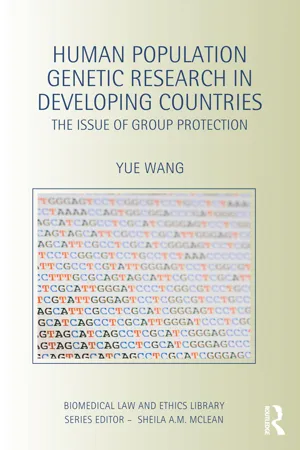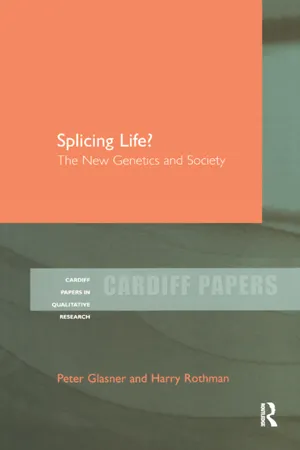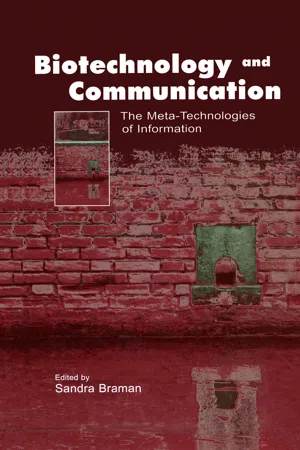Biological Sciences
Genetic Information
Genetic information refers to the heritable material that determines the traits and characteristics of an organism. It is encoded in the DNA and RNA molecules and is passed from one generation to the next. This information contains the instructions for the development, functioning, and reproduction of living organisms.
Written by Perlego with AI-assistance
Related key terms
5 Key excerpts on "Genetic Information"
- eBook - ePub
Human Population Genetic Research in Developing Countries
The Issue of Group Protection
- Yue Wang(Author)
- 2013(Publication Date)
- Routledge(Publisher)
(a) It is a relatively independent unit of heredity. As an information unit, a gene can refresh combinations of the genetic make-up of both parents by transferring them to offspring. What is more, a gene can instruct, influence and even decide creatures’ traits, such as body structure and living habits.(b) At a molecular level, a gene is a segment of a DNA molecule, the sequences of nucleotides (or bases) in genes represent the heredity of human beings and other creatures. The information in a gene is encoded in the sequence of base groups of DNA.(c) Genes are specific sequences of bases that encode instructions on how to make proteins.8 Gene sequences of DNA, when transferred into strands of messenger RNA, could be used as the basis for building their related protein piece by piece. The gene could not only transmit all of this information through replication, but also could dominate the organism’s character by controlling the process of synthesizing protein, which is called ‘gene expression’. In other words, a gene exerts its physical function through directing the production of proteins and RNA molecules.Genetic Information What is Genetic InformationAccording to Article 2(i) of the UNESCO International Declaration on Human Genetic Data, human genetic data is ‘the information about heritable characteristics of individuals obtained by analysis of nucleic acids or by other scientific analysis’.9 Although the intention of this definition is merely to set out the relationship between human Genetic Information and scientific research, it suggests that the real value of the gene is not its physical substance but the information carried in it.In general, Genetic Information is the information for making all of the proteins required by all organisms. These proteins determine, among other things, how the organism looks, how well its body metabolises food or fights infection, and sometimes even how it behaves.10 - eBook - ePub
Splicing Life?
The New Genetics and Society
- Peter Glasner, Harry Rothman(Authors)
- 2017(Publication Date)
- Routledge(Publisher)
Chapter 4 Managing Genetic InformationIn this chapter we discuss three related issues involved in managing different kinds of Genetic Information: biobanking; privacy and personal genetic data; and bioinformatics. Managing Genetic Information in society normally occurs through a combination of professional ethical codes, and state regulatory regimes. Personal Genetic Information is usually defined as including: genotype – detail at the level of DNA or protein; phenotype – observable outcomes in terms of physical characteristics; and family information – recorded patterns of inheritance of different phenotypes. Genotype information is generally obtained either by direct analysis of DNA or of proteins or other bodily chemicals. Phenotype information is gathered in many different ways including tests of tissue or fluid samples, X-rays, or physical observation and measurement. Family information is normally gathered through family histories taken by clinicians and health professionals. The personal or social significance of these different forms of information varies significantly. The other main type of Genetic Information is the data generated through the mapping and sequencing of genomes, particularly the human genome, and stored in digital form in public databases. Attempts to deal with issues associated with managing the data explosion generated by the HGP and its applications include scientists working collaboratively using electronic forms of communication.BiobankingThe completion of the mapping of the human genome has generated a vast quantity of raw sequence data that is of little use until the function of a particular gene and its role in pathology is known. The move to functional genomics discussed in chapter three - eBook - ePub
- Cédric Gaucherel, Pierre-Henri Gouyon, Jean-Louis Dessalles(Authors)
- 2018(Publication Date)
- Wiley-ISTE(Publisher)
2 Genetic Information We started out with a view of information in the form that is most intuitive and most familiar to us, that is information in human communication. This notion of information involves a sender and a receiver, as well as a supporting code or language. We saw that this notion could easily be extended to animal communication. Can we go further, and speak of information, language and code in connection with biology in general? Of course we can. A domain of biology in which information plays a leading role, and which deserves a close study in its own right, is genetics. How this field is related to information, language, code and the specific features of that relationship are issues that we will consider in the following. 2.1. A central concept in biology Molecular biology devotes particular attention to information that is transmitted from generation to generation. The message of heredity is generally carried by an element of DNA. DNA is a linear chain consisting of pairs of nucleotides. The four nucleotides that constitute DNA are designated by the letters A, T, G and C, which stand for the corresponding molecules that are the chemical bases: adenine, thymine, guanine and cytosine. However, DNA does not resemble a string of pearls, in which each base would be one of four possible bases. Instead, it is more like a ladder (see Figure 1.1), in which each rung is a pair of nucleotides. This happens because of the affinities that exist between A and T, and between C and G. These affinities arise from hydrogen bonds that are strong enough to preserve their association, but not strong enough to make that association irreversible. The sequence of nucleotides is made complete by its complement, thus producing the well-known double helix that James Watson and Francis Crick discovered in 1953. The ladder was seen to be twisted so as to appear shaped like a helix. Each nucleotide faces its complement on this ladder – A with T, T with A, C with G, G with C - eBook - ePub
Biotechnology and Communication
The Meta-Technologies of Information
- Sandra Braman, Sandra Braman(Authors)
- 2004(Publication Date)
- Routledge(Publisher)
The confusions are two, both deriving from one of the most ancient of philosophical problems—the difficulty of understanding the relationship between the intangible and tangible. First, in the popular imagination, the physical material in which Genetic Information is embedded—DNA—is often equated with the information embedded within the DNA itself. This is akin to mistaking the physical object of a book for the information contained within it. Second, the distinction between the genotype (the Genetic Information of which an organism is comprised) and phenotype (the manifestation of that Genetic Information in the material world) is often conflated. The phenotype results from interactions of the genotype with particular environments. Indeed, within any one species there may be thousands of the genetically variable populations derived from differential responses to environmental conditions known as landraces. Although it is tempting to think of the genotype as an ideal Platonic form, it is more accurately described as a potential for a myriad of possible forms out of which one will be selected by the environment and the history of an individual within it. There are important implications of this difference in the social world: It is one reason that, for example, genetic testing in the workplace should not be grounds for excluding certain workers from particular jobs because there is no way to know whether a genotype will be expressed phenotypically in any particular individual and/or context. There is in reality no single normal genotype, but rather an entire spectrum of genotypes should be considered normal (Suzuki & Knudtson, 1989). It is the genotype that is the Genetic Information discussed here.Because of these two confusions, the word “gene” no longer has meaning for molecular biologists. “But,” note Hubbard and Wald (1993), “since genes remain very much a part of the science of genetics, as well as of the culture at large, experiments with DNA get communicated in the language of genes” (p. 43). The result is ambiguity. Although DNA, the genotype, and the phenotype are so intertwined that it is not always clear which is being discussed, the actual complexity of Genetic Information often gets translated—both within the scientific community and without—into a machine-like metaphor that emphasizes the ability of humans to control it (Haraway, 1976; Nelkin & Lindee, 1995; Woodward, 1994). Even when there is no such confusion regarding Genetic Information, however, there are first order, second order, and third order facticity issues. - eBook - ePub
Genome Chaos
Rethinking Genetics, Evolution, and Molecular Medicine
- Henry H. Heng(Author)
- 2019(Publication Date)
- Academic Press(Publisher)
A genome is the full set of instructions needed to make every cell, tissue, and organ in your body. Almost every one of your cells contains a complete copy of these instructions, written in the four letter language of DNA (A, C, T, and G).http://www.broadinstitute.org/education/glossary/genomeAll the genetic material in the chromosomes of a particular organism. The size of a genome is generally given as its total number of base pairs.Kevles and Hood, 1992The haploid set of chromosomes in a gamete or microorganism. Or in each cell of a multicellular organism, and more specifically, “The complete set of gene or genetic material present in a cell or organism.”Oxford living dictionariesKeller has listed a range of definitions for the genome (both “official” and semi-official), coupled with historical discussions about the relationship between genes, the genome, and genomics (Keller, 2011 ).Among all these different definitions, a common thread is the mention of “genes or genetic materials.” In addition, “genetic instructions” are sometimes vaguely mentioned. For those definitions that include chromosomes, they mainly focus on the fact that genes are located on chromosomes. No specific function of inheritance is discussed at the chromosomal level, and no topological and organizing roles of chromosomes are mentioned. In summary, all definitions have focused on the genetic materials, rather than the organization of these materials. It is no wonder then that the project of sequencing all genes has been termed “the genome project” rather than “the gene sequencing project,” and the decoding of individual genes equals the decoding of the genome (the relationship among genes) to most researchers.As a consequence, the current improper use of the term “genome” represents one of the biggest confusions in current genomics, which has also generated many misconceptions in other related fields of bioscience. For example, many consider the gene to be the independent unit of inheritance, and the individual gene or combinations thereof to be responsible for genetic traits, whereas few believe that chromosomes are more important for organizing genomic information; the gene is extensively used as the unit for cellular and organismal evolution studies, and only a few researchers still use karyotypes to study macroevolution (and if they do, they are often considered outdated); it is believed that most complex diseases can be understood by tracing these diseases back to less than a handful of genes, and studying chromosomal aberrations serves only as a tool to identify gene mutations. Almost all molecular genetic research follows the gene and its related aspects. Ironically, the characterization of chromosomal aberrations is often viewed by some as descriptive studies (a very negative comment from the NIH study sections aimed to kill proposals). However, the characterization of gene mutations (clearly, a description at another level) is not considered descriptive but rather mechanistic research.
Index pages curate the most relevant extracts from our library of academic textbooks. They’ve been created using an in-house natural language model (NLM), each adding context and meaning to key research topics.




